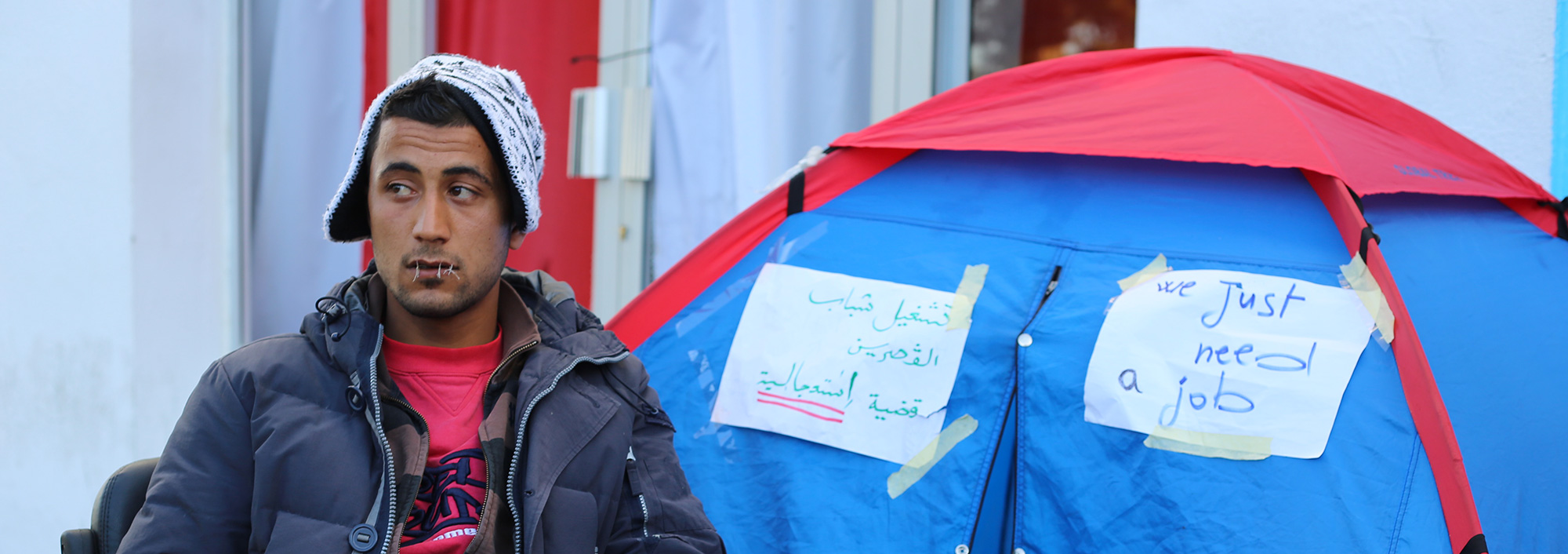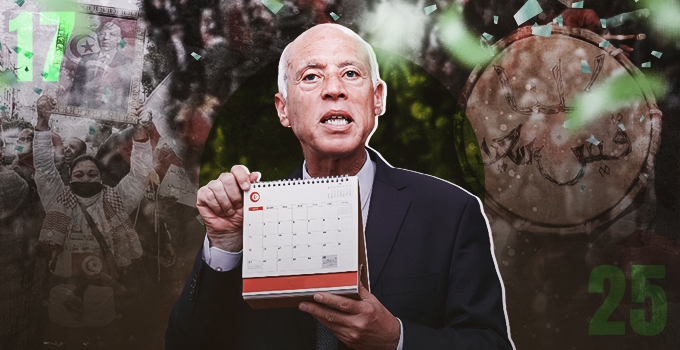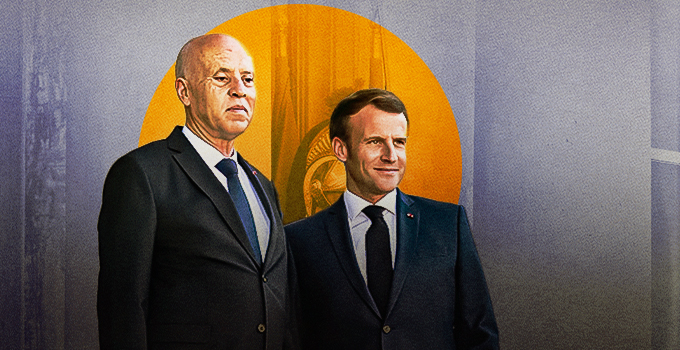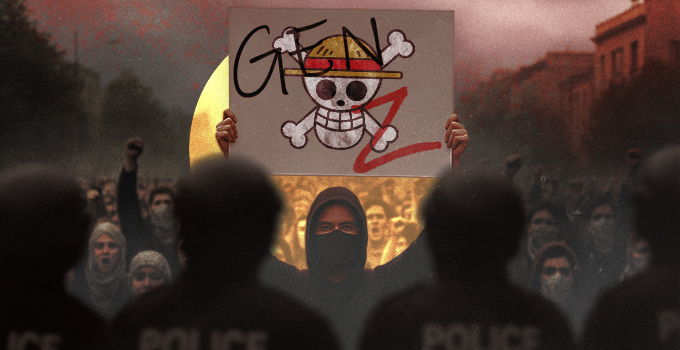1
Five years after the onset of the sociopolitical explosion, “the Arab Spring,” Tunisia, the country where it began is bogged down in a deepening socio-economic crisis, lack of political vision (this despite a highly educated, sophisticated and politically savvy population) and an ongoing guerrilla war against Islamic radicals in the western and southern regions of the country that the government has not been able to extinguish, nor even bring under control. Although put forth as a kind of poster child for what might be considered the one “Arab Spring success story,” in fact, Tunisia is a country where disillusionment at successive government’s paralysis to address the crisis runs deep. If not for the repeated intervention of Tunisia’s civil society – its youth, civil rights organizations, labor unions – to push the government to act, the situation would most probably be even worse that it currently is.

It should come as much of a surprise then, that five brief and tumultuous years after the start of the Arab Spring, that it would once again explode. That “it” – a spontaneous uprising in the country’s interior that spread to a number of towns and cities – shook them to their very core – is beyond doubt. For a moment it appeared that, as they have in the past, both more recent and less so, the angry protests that started in the Tunisian interior town of Kasserine and quickly ignited elsewhere (Gafsa, Jendouba, Tozeur, Gabes, Medenine).
While Tunisia’s official unemployment rate stands at 15%, in Kasserine it stands at double that. A protesting youth holds a poster in the center of Kasserine that says it all. “We are hungry and very, very angry.” The Kasserine protest which has been going on for months, took on a new urgency when on January 16 of this year, Ridha Yahyaoui, a young unemployed college graduate climbed a telephone pole in downtown Kassserine, threatening to commit suicide. It appears he accidentally touched a high tension wire, electrocuted he fell to his death. The event triggered protests across Tunisia with thousands of youth taking to the streets to demand jobs. Nervously, the official response in Tunis was an announcement by the Council of Ministers to immediately create 5000 jobs in the Kasserine region. But only the next day, the decision was reversed after angry demonstrations nationwide demanded the same thing elsewhere in the country.
But then Ridha Yahyaoui is only the last of a growing number of Tunisians – youth or otherwise – who have committed suicide, many of the through immolation. In fact, while Yahyaoui’s tragic death was noted by the media, both in Tunisian beyond, so many others have not drawn any attention at all. An indication of the disillusionment sweeping the country is a new phenomenon: suicide and suicide by fire. Seems to be the route to the great beyond taken by more and more Tunisians who look into the future and see….nothing.
Recall how in late 2010 Mohammed Bouazizi immolated himself in the interior town of Sidi Bouzid, his death sparking the nationwide demonstrations that changed the face of the country at that time. But immolation hasn’t ended. If anything it has spread like a social cancer. In fact according to one report, more than 500 Tunisians attempted suicide in 2015 alone; of those 302 succeeded and of those who succeeded 105 chose suicide by fire, immolation as the way to end their lives. Add to that number the 56 that have killed themselves since Jan 1, 2016 (of which 22 are immolations).
In this most recent uprising, clashes between the police and demonstrators left one policeman dead and hundreds of protesters arrested. The great fear was that they could spread from there to the coastal cities of Tunis, Sfax, Souuse and Bizerte triggering the kind of national uprising that forced former Tunisian President Zini Ben Ali, his extended family and that of his rapacious wife, Leila Trabelsi, to flee from the country (after a quick stop at the country’s national bank to carry off all the gold they could carry). This time the uprising was crushed and the country’s 88 year old President, Beji Caid Essebsi, blaming the protests on outside forces rather than seeing them for what they were: an angry response to the unfulfilled legacy and promise of January 2011.

In fact the pattern of rural rebellions that overflow into coastal urban areas in Tunisia is as old as the hills, described in some detail by 14th century scholar, Ibn Khaldun, in his thoroughly modern and still readable “The Muqaddimah” (The Introduction, or Prologue – in English). Building in many ways on Ibn Khaldun’s work, modern political philosophers like Immanuel Wallerstein, refer to the same processes as “the revolt of the periphery” of the modern world system, in which the poorer, heavily exploited “periphery” that produces mostly basic raw materials and food stuffs rebels against the inequities imposed upon it by “the core” – or urban areas.
Under the weight of government repression and the failure of the more heavily populated coastal cities to join the interior, this time the movement fizzled – although weeks later there were still peaceful protests throughout the country. But still, it was “a warning shot” so to speak – a shot across the bow of the Tunisian ship of state, that the movement which swept the Ben Ali’s from power a mere five years ago, could do this same to the current government headed up by Beji Caid Essebsi. But if the uprising was contained, still, it once again shook the foundations of the Tunisian political class and ripped the mask off of the illusion, popular in Europe and North America, that Tunisia, it’s Nobel Peace Prize aside, represents something of the Arab Spring’s only “success stories.”
In fact, a more sober picture emerges. Since Ben Ali’s demise, an event celebrated throughout the country and beyond, Tunisia has been frozen in its tracks, the economy sputtering along in near cryonic suspension, kept afloat by infusions of foreign aid with the usual strings attached, the political system in turmoil despite the success of crafting a new constitution, and the government failing to reign in the country’s radical Islamic faction, fed in part by the collapse of Libya, but also by post-Ben Ali religious political factionalism. Ironically – or perhaps the better adjective here would be “sadly” enough, the same themes raised before Ben Ali fled five years ago are being repeated in 2016: work, freedom, dignity. Although “the transition” as it is called continues, it has proceeded at a snail’s pace.
As former French correspondent for the Financial Times, Francois Ghiles noted in an on-line article at Open-Democracy:
This is a country whose government seems unwilling or incapable of conducting desperately needed reforms, and whose economy is flat; where living conditions for the majority have deteriorated since they overthrew their erstwhile dictator, Ben Ali, five years ago. Two of the three engines of growth, tourism and the phosphate/fertilizer industry, have stalled and unemployment among the young in Kasserine, one of the towns which revolted in 2011 has increased to nearly 25% among young men and 38% among young women. This is a country where neither major party, the Islamist Ennahda party that governed from 2012 to 2014 and the lay coalition Nidaa Tounes currently in power, dares to take bold economic decisions. Foreign debt meanwhile is piling up at an alarming rate.
What is missing in all this is both a long-term vision of how the country’s economic future might be shaped, and more short and medium term programs to get the country’s economy even headed in a new direction. This has been the problem since the new constellation of political forces came to power after January 2011.
The situation would be even worse if not from the repeated “voice of the people” – Tunisia’s civil society – its youth especially, but also its trade unions, intelligentsia, its long-established moderate Islamic institutions and traditions. It is possible that without the continued intervention – through mass demonstrations, activism of Tunisian civil society – which remains a genuine force for positive change and deserving of the Nobel Peace prize – that Tunisia easily could have gone the sorry route of Syria and Libya.
The different elements of civil society have come together again and again these past five years – whether it was to oppose the assassinations of its moral leadership (Chokri Belaid and Mohammed Brahmi), to challenge the no-nothing policies and religious factionalism of its post Ennahdha- led political party, to oppose the vicious terrorist attacks in at the Tunis Bardo Museum and on the beaches of Sousse or now, to press the government of Beji Caid Essebsi to be responsive to the mounting socio-economic needs of the Tunisian people.

2
In late 2010, just prior to what was the national uprising which triggered Ben Ali’s overthrow, “the action” so to speak centered around the interior town of Gafsa, deep inside Tunisia’s interior, 198 Km (124 miles) from the coastal city of Sfax. The main issue was unemployment as the country’s phosphate mining industry had gone from employing 20,000 workers to a mere 8,000 over the course of prior twenty years or so. No economic development program to absorb the unemployed labor had been seriously considered. When a number of community and labor leaders were arrested for demonstrating for jobs, the region, and soon thereafter, the entire country exploded.
The Tunisian events of 2010-2011 not only rocked Tunisia but set in motion “the Arab Spring” (the announcement of death of which, this author believes entirely pre-mature) – nothing short of a Middle East, North Africa (MENA) region wide rebellion that shook, and continues to shake, the world. As with the rest of the region, the Tunisian Revolution – if one can call it that – remains an unfinished work. Some, but not all of the past, has been swept away, what might be called, the surface gunk. Looking back on historic moment five years on, a number of themes emerge.
1. Religion played virtually no role in the events. That the slogans, if one likes, the program of the uprising, what motivated almost an entire nation to take to the streets, for many to risk and give their lives, were seemingly forgotten by many within months after the Ben Ali’s had fled the country. It had three essential goals – greater economic prosperity for a greater percentage of the population, greater democracy (including freedom of speech) in a country that had become increasingly totalitarian and an end to the pervasive corruption, greed and repression that were the hallmarks of the Ben Ali – Trabelsi period.
Put another way, this was a revolt about “bread and roses” and if it triggered a region wide movement in its wake it is because the problems of Tunisia were by no means unique to this small North African country wedged between the two oil-giant neighbors, Algeria and Libya. What stood out at the time was the degree to which how little religion was a moving factor in the uprising. Indeed, it is no exaggeration to say that it played no role at all at the time. Questions which would nag at the nation soon after such as “what kind of Muslim are you” – were irrelevant, in large measure because the nation has long been overwhelmingly Sunni Muslim (with its own North African brand that recognized what are referred to as marabouts). No, it was all about the economic and political system which had been in turmoil for decades.
This begs the question, that if religion, the kind of Islam to be practiced in the country and its relationship to the national identity, played no role in the uprising – and the religious parties – the Salafists, the Ennahdha Party were not significant factors in the revolt, how is it that religious issues can to the fore with such force soon thereafter and that a political party like Ennahdha, essentially the Muslim Brotherhood chapter in Tunisia closely coordinating its politics with like elements in Turkey, Egypt and Qatar, was able to dominate the Tunisian political scene?
2. Those who “made the revolution” were not those who came to power afterwards. In fact, for the most part, “they” were almost immediately side-lined and those who were able to maintain influence, did so only for a short time. Who were “they”? Well, most of the country, but with unemployed youth playing a major role…soon joined by civil society organizations, labor (at first locally and then nationally), small business …and even some very wealthy elements in Tunisian society whose prosperity was being sidelined or stolen by the Ben Ali and Trabelsi clans.
But what stands out about them, was that while had the force to expel Ben Ali, that they were not organized into a political force with a program and a vision. I would also point out here that there has been a global tendency going back to the movement in the Philippines to unseat the Marcos’s to rid a country of a dictator…but not change, or hardly change, the system. As with the movements in Eastern Europe and the USSR to overthrow communism, those elements that actually triggered the changes, who organized and sacrificed to bring down the system, were, like the Tunisian radicals, quickly sidelined and neutralized. To what degree was this “planned” by “outside forces” is difficult to prove, …although there is no doubt, that in the Tunisian case, “outside forces” – both in the Middle East and beyond were actively and openly involved.
3. It is startling, looking at Tunisia today, from an institutional view-point, how little has changed from the Ben Ali period. And here I would like to elaborate in a bit more detail.
a. What hasn’t changed at all – is the economic model. Tunisia remains a semi-peripheral export-oriented economy whose two major markets – thus its economic survival – being France and Italy. It remains committed, as it was during the Ben Ali period to IMF-World Bank structural adjustment arrangements – with all they entail – as conditional to receiving needed economic aid without which, it is highly possible the country’s economy would collapse. Such policies, if giving short term relief, have done little to nothing to put the country on a new, different, dearly needed path, and worse. Rhetoric aside, there has been no – literally nothing – in terms of infra-structural, economic development plans for the country’s interior and southern regions. If anything the unemployment level is even higher today than it was in January 2011.
When one remembers, that the 2011 uprising was primarily triggered by economic and social disparities and that now those disparities are not only growing, but that nothing has been done to narrow the gap, it suggests that social explosions will inevitably continue.
b. Very little changes in the country’s main institutions – the Ministry of Interior, the banking and financial sectors, the political and economic players in the country – minus the Ben Ali’s – have remained largely in tact. Ennahdha did add a new element…but essentially made its agreements with the old Ben Ali-installed order. That a figure as stale (as well as undemocratic, and essentially something approaching senile) as Beji Caid Essebsi could emerge as the country’s leading political figure is a powerful indication of how little things have changed. Essebsi has brought with him a good many people active in the economy and politics from Ben Ali era. Essebsi’s Nidaa Tounes party includes many members of Ben Ali’s old Rassemblement Constitutionnel Démocratique (RCD) party.There is so much just plain circulated of old blood in the new order, which is in fact, the old order with a new, and often not even that new, vocabulary.
Where is it all headed? Can the positive momentum, hope for the future outpace the looming social shadows hanging over the country?
This article was originally published in View from the Left Bank.





Rob, for a moment, I thought you gave up writing about the Arab-Spring , and honestly I don’t blame you (!) You must have felt the same disappointment, that many of us had to swallow whole, after losing that glimpse of hope we’ve rightfully cherished, and thought that the people of Tunisia will cling to this unique opportunity and make the very best of it . But we blew it . There were too many invisible forces at work, with the objective of dealing a fatal blow to the tunisian”Spring”, and with considerable success, unfortunately .
We will sit and wait . We’re very good at that, apparently .
If there was a world championship, in sitting & waiting, we’ll get a gold medal (!) .